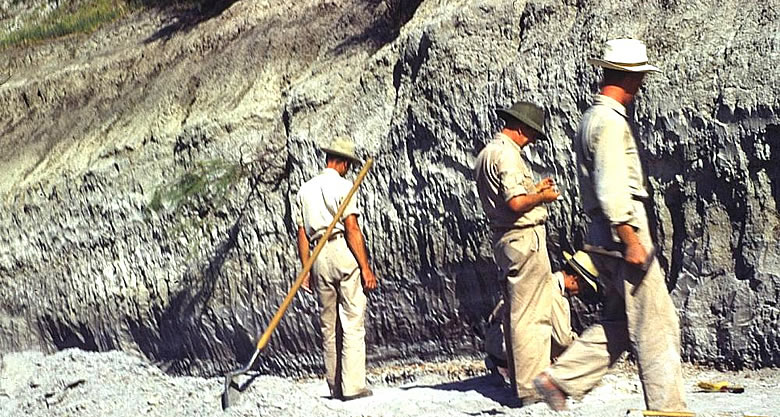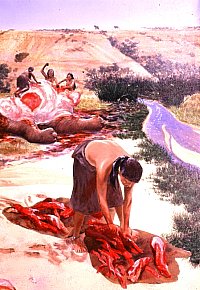
A woman cuts strips of mammoth (Ice-Age
elephant) meat on a hide, perhaps to be carried elsewhere
for dinner. In the background, the beast is being carved
up.
|
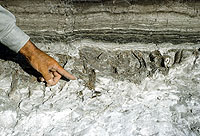
Folsom point found in place amid
bones of extinct bison, June,1951.
|
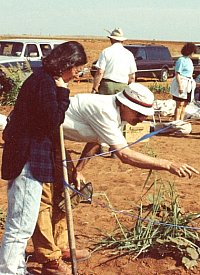
Geoarcheologist Vance Holliday points
out new evidence to TAS Field School Director Eileen
Johnson.
|
|
For over 13,000 years the inhabitants and visitors
to the Llano Estacado (Staked Plains) have frequented a locale
known today as the Lubbock Lake Landmark. Until recently the
main attraction was a major spring that flowed out of the
Ogallala aquifer and into Yellowhouse Draw. The abundant water
and sheltered draw was a haven for plants and animals. The
water, plants, and animals drew humans, beginning with Clovis
hunters and their families and continuing right on up into
historic times, each leaving behind a few traces. The end
result is an archeological record that has few parallels in
the southern High Plains—layer after layer reflecting
changing climates, environments, and cultures. Archeologists
and other scientists have been studying the Lubbock Lake site
for over 65 years and there is still much to be learned from
this remarkable locale.
The place takes its name from a reservoir created
in the 1930s in a U-shaped bend of Yellowhouse Draw, a tributary
of the Brazos River. Up until the late 1880s, a natural, spring-fed
lake existed in this same area. In the early 1900s, the springs
began to dry up, the victim of too many thirsty people and
their bountiful crops. In the late 1930s a project to dig
out (and hopefully renew) the springs turned up Folsom points
and other evidence of Paleoindian peoples. This led to the
first archeological digs in 1939 and 1941 under the sponsorship
of the Works Progress Administration (WPA). To run the excavation,
W. Curry Holden, Director of the West Texas Museum (now the
Museum of Texas Tech University) hired Joe Ben Wheat, a young
Texan who would later become a noted Paleoindian expert. But
everywhere the WPA crew dug, they soon hit water. While the
springs never came back, the water table had been raised temporarily
by the creation of the artificial reservoir. The Folsom deposits
lay deep below the water table and only a few Paleoindian
artifacts were recovered.
By the late 1940s, irrigation wells had drawn
down the water table considerably lower, making the Folsom-age
deposits accessible. Holden permitted new excavations to be
carried out under the direction of E.H. Sellards, Director
of the Texas Memorial Museum (TMM) at UT Austin. Sellards
and his TMM teams had been exploring a series of "Early
Man" sites including the famous Blackwater Draw in eastern
New Mexico. Geologist Glen Evans and paleontologist Grayson
Meade were in charge of the intermittent field work between
1948-1955 at Lubbock Lake. The main excavations were undertaken
in 1950-1951. Taking advantage of the lower water tables and
the almost vertical walls of the dredged-out waterway, Evans
and Meade were able to document a complex sequence of natural
and cultural deposits including bone beds associated with
Folsom artifacts. Glen Evans' color photographs can be seen
in the TMM 1950-1951
Photo Gallery.
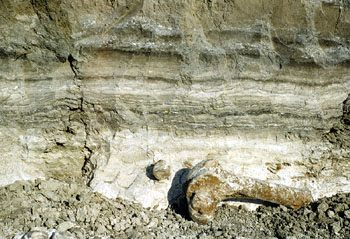
Leg bone from extinct bison found in Bed 2,
notable for the finely banded layers of diatomite, pond
deposits of one-celled, algae-like organisms.
Since 1972, the Lubbock Lake Landmark has been
investigated by archeologist Dr. Eileen Johnson and geoarcheologist
Dr. Vance Holliday and their students and associates. Field
research has taken place almost every summer. The hallmark
of their work has been meticulous documentation borne out
of the realization that at Lubbock Lake most archeological
deposits are the result of one-time events. Here the smallest
trace can be a crucial clue to unraveling a "day-in-the-life"
occupational episode—a bison kill, an overnight camp,
a meal—sealed by the almost unbroken deposition of wind-borne
dust, overbank flood mud, or pond and marsh deposits.
Lubbock Lake is now a state and federal historic
landmark protected by a 336-acre preserve on the north side
of the city of Lubbock, Texas. The park contains the Lubbock
Lake Landmark (which includes a series of nearby archeological
locales along Yellowhouse Draw), an interpretive center, and
a research center operated by the Museum of Texas Tech University.
Today anyone can visit the interpretive center,
see the incredible outdoor display of life-size bronze statues
of Ice-Age animals, and sign up to participate in workshops
and tours. This is one of the most accessible archeological
and paleontological sites in Texas.. The interpretive center
has a very active public education program that involves thousands
of school children in the region every year. Check out the
Lubbock
Lake Landmark website for details.
You can get a closer look now at some of the
vivid "day-in-the-life" recreations created by artists
from the Texas Parks and Wildlife Department for the Lubbock
Lake Landmark Interpretive Center in our special Mural
and Diorama Gallery.
Under the archeological leadership of Dr. Eileen
Johnson, the Texas
Archeological Society (TAS) held its 33rd annual
field school at Lubbock Lake Landmark June 3-11, 1993. Some
225 TAS members carried out site surveys and excavations at
various locales within the Landmark and at several ranches
elsewhere in the area. The biggest challenge was the relentless
wind and the dusty bone-dry conditions it brought. The campers'
tents "shook and flapped, and some collapsed" as
Dr. E. Mott Davis put it. In hindsight, it seems fitting that
those taking part in the field school had to face the exact
same forces of nature that shaped the Lubbock Lake Landmark
throughout its history. You can get a good look at many of
the activities in the TAS
1993 Photo Gallery.
|

Lubbock Lake Reservoir dredged out
and dried up, August, 1950. Unidentified man stands
above exposure where Folsom deposits were found.
Click images to enlarge
|
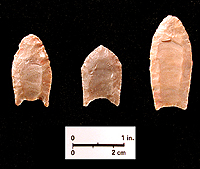
Folsom points from TMM excavations.
The specimen on the left and the one on the right are
casts of the originals.
|
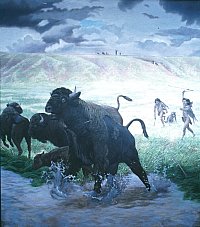
Archaic hunters spring up from the
grass to hurl darts with atlatls at bison at the lake's
edge. The hunters disguised themselves as wolves and
slowly crept closer before springing. On the horizon
family members watch the scene hoping for a successful
hunt.
|
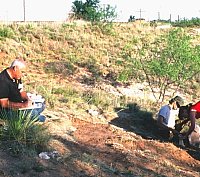
Jaq Jaquier takes note as TAS members
begin a new excavation at Lubbock Lake Landmark.
|
|
